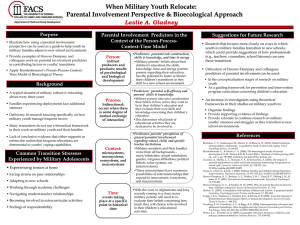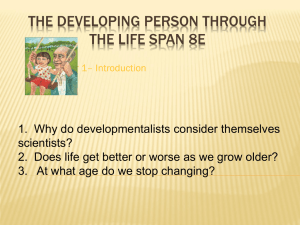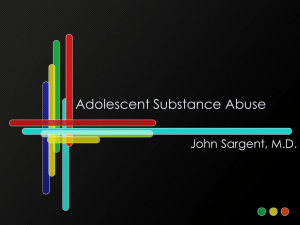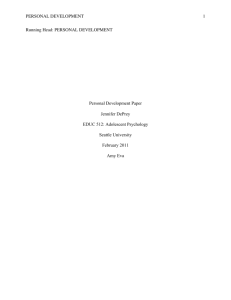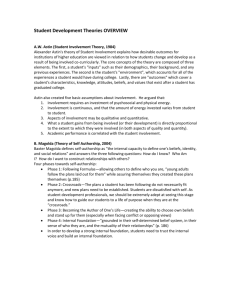Ecological Systems Theory: The Person in the Center of the Circles
advertisement
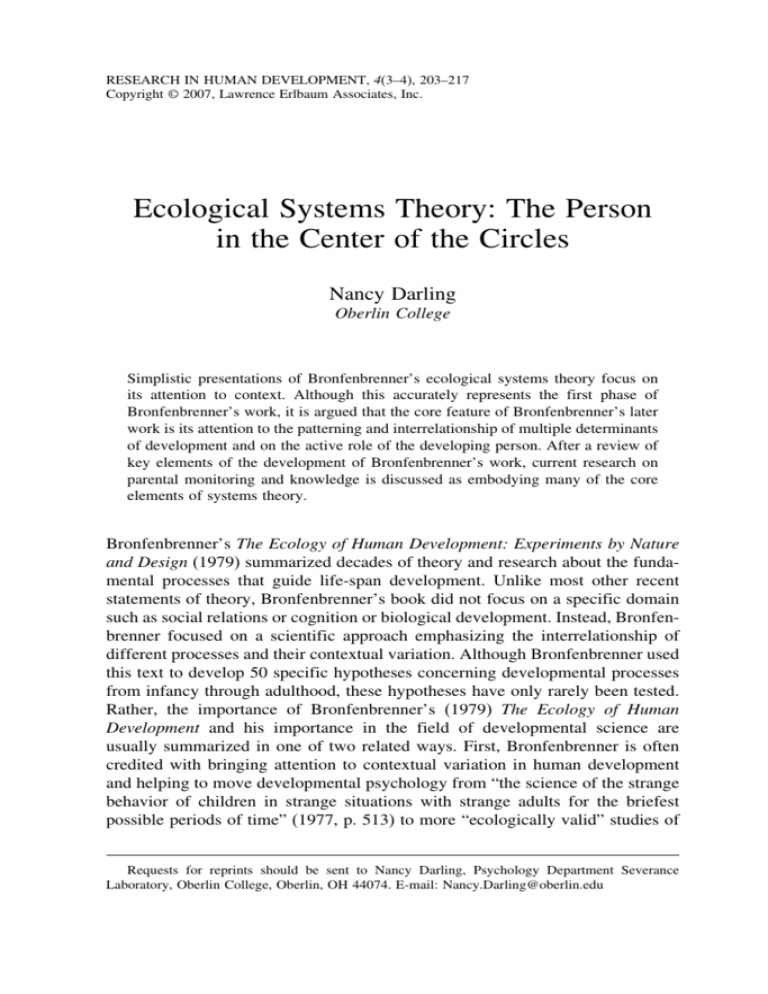
RESEARCH IN HUMAN DEVELOPMENT, 4(3–4), 203–217 Copyright © 2007, Lawrence Erlbaum Associates, Inc. Ecological Systems Theory: The Person in the Center of the Circles Nancy Darling Oberlin College Simplistic presentations of Bronfenbrenner’s ecological systems theory focus on its attention to context. Although this accurately represents the first phase of Bronfenbrenner’s work, it is argued that the core feature of Bronfenbrenner’s later work is its attention to the patterning and interrelationship of multiple determinants of development and on the active role of the developing person. After a review of key elements of the development of Bronfenbrenner’s work, current research on parental monitoring and knowledge is discussed as embodying many of the core elements of systems theory. Bronfenbrenner’s The Ecology of Human Development: Experiments by Nature and Design (1979) summarized decades of theory and research about the fundamental processes that guide life-span development. Unlike most other recent statements of theory, Bronfenbrenner’s book did not focus on a specific domain such as social relations or cognition or biological development. Instead, Bronfenbrenner focused on a scientific approach emphasizing the interrelationship of different processes and their contextual variation. Although Bronfenbrenner used this text to develop 50 specific hypotheses concerning developmental processes from infancy through adulthood, these hypotheses have only rarely been tested. Rather, the importance of Bronfenbrenner’s (1979) The Ecology of Human Development and his importance in the field of developmental science are usually summarized in one of two related ways. First, Bronfenbrenner is often credited with bringing attention to contextual variation in human development and helping to move developmental psychology from “the science of the strange behavior of children in strange situations with strange adults for the briefest possible periods of time” (1977, p. 513) to more “ecologically valid” studies of Requests for reprints should be sent to Nancy Darling, Psychology Department Severance Laboratory, Oberlin College, Oberlin, OH 44074. E-mail: Nancy.Darling@oberlin.edu 204 DARLING developing individuals in their natural environment. Second, just as Piaget’s rich work is often represented in introductory textbooks by a brief table summarizing his stage theory, Bronfenbrenner’s work is often summarized with a diagram of “ecological theory.” Flip open almost any introductory textbook on child development and you will find a figure in which the individual—almost always a toddler—is seen at the center of a series of concentric circles representing microsystems, mesosystems, exosystems, and macrosystems. Connecting these circles are multiple arrows linking contexts within systems (nursery school to neighborhood) and linking contexts across systems (family to school). It is a busy and complex world with a passive (and isolated) child at the center. More charitably, ecological systems theory is presented as a theory of human development in which everything is seen as interrelated and our knowledge of development is bounded by context, culture, and history. Although important, neither of these two ideas strikes me as the core of Bronfenbrenner’s work nor of his ongoing legacy. Rather, I see the core and promise of Bronfenbrenner’s work within three domains, just now being fully exploited by developmental scientists. First, the central force in development is the active person: shaping environments, evoking responses from them, and reacting to them. Second, a fundamental premise of ecological system theory is its phenomenological nature: “[I]f men define situations as real they are real in their consequences” (Thomas & Thomas, 1929, p. 572). Finally, because different environments will have different affordances and will be responded to in different ways by different individuals, experienced and objectively defined environments will not be randomly distributed with regard to the developmental processes and the individuals one observes within them. Rather, one will find ecological niches in which distinct processes and outcomes will be observed. Bronfenbrenner developed these core elements in a series of papers written after the Ecology of Human Development (e.g., 2001; Bronfenbrenner & Morris, 1998) in what he described as an important critique and reformulation of ecological theory and the second phase of his work (Bronfenbrenner, 1999). As a student of Bronfenbrenner’s, I began this piece by trying to put his work in context in an effort to understand its developmental history and to predict its continued growth. Reviewing over six decades of work is a formidable task, replete with surprises and starts of recognition. A few pieces stood out as representing key elements of Bronfenbrenner’s thinking: a relatively early piece on historical variability in social class differences in parenting (Bronfenbrenner, 1958), a piece on gender differences in the association of parenting and leadership (Bronfenbrenner, 1961), the series of articles and then books focusing on cultural variability in socialization (e.g., Bronfenbrenner, 1970), and of course, the systematic development of ecological systems theory (e.g., Bronfenbrenner, 1977, 1979, 2005; Bronfenbrenner & Ceci, 1994; Bronfenbrenner & Morris, 1998). There were also the surprising flights of ECOLOGICAL SYSTEMS THEORY 205 intellect: a masterful integration of Freudian and social learning theory focusing on the role of the individual (Bronfenbrenner, 1960), the statistical work (e.g., Bronfenbrenner, 1945), and the many articles, reports, and speeches written advocating social policy changes in support of children and family, including Head Start. Several themes emerged from even the earliest writings that remained central throughout Bronfenbrenner’s later work: social and historical context, the active person, and the impossibility of understanding individual developmental processes in isolation. For example, in “Socialization and Social Class Through Time and Space,” Bronfenbrenner (1958) attempted to bring coherence to contradictory evidence concerning the relative warmth and strictness of middle- and working-class parents. By examining historical time in conjunction with social class, Bronfenbrenner argued that parenting practices had shifted with the recommendations of child development experts and pediatricians but that the adaptation of expert advice was not uniform across society. Because middleclass parents placed greater trust in experts, their practices were closely linked to patterns of expert advice. The practices of working-class parents shifted more slowly, lagging behind by 10 to 15 years before moving toward middle-class norms. As expert advice changed from discipline centered to support centered and back again, class differences shifted as well. Note the attention played to identical processes differing in expression in different social and historical contexts. Attention to patterning is similarly important in a later piece (Bronfenbrenner, 1961), focusing on gender. Bronfenbrenner again described how what seemed to be the same processes predicted different outcomes for boys and girls. Specifically, Bronfenbrenner wrote that “affiliative companionship, nurturance, principled discipline, affection, and affective reward appear to foster the emergence of leadership in sons but discourage it in daughters” (p. 256). Bronfenbrenner did not attribute these differences to some inherent quality of boys and girls (not an uncommon attribution in the early 1960s) nor to the different socialized needs or expectations of boys and girls (a “nurture”-based explanation). Rather, Bronfenbrenner interpreted the processes as differing in effect because their meaning differed for adolescents in the context of dominant socialization practices. First, Bronfenbrenner noted that the disciplinary practices used for girls tended to be more “love oriented” than the “punishment-oriented” discipline practices used for boys. Whereas love-oriented practices tend to induce high compliance and sensitivity to social cues, punishment-oriented discipline tends to foster greater independence. Combined with greater overall warmth of parents toward girls than boys, Bronfenbrenner argued that typical disciplinary practices would move girls toward dependence and attention to adult standards and boys toward independence and autonomy. In a characteristic use of evidence taken from disparate research areas, Bronfenbrenner noted that a 206 DARLING markedly similar pattern can be seen in first-born and later-born siblings and with similar effect. In conversation, Bronfenbrenner often described the normative developmental risk to boys as “undertaming”—failure of discipline and inadequate compliance with social norms. For girls, Bronfenbrenner saw the risk as “overtaming”—failure to foster autonomy and self-expression. Again, the focal point for Bronfenbrenner was not in the form of discipline nor in the innate qualities that boys and girls bring to the situation. Instead, the effect of discipline had to be understood within the context of the parent–child relationship and dominant cultural conditions. Many years later, Bronfenbrenner (1985) described the optimal balance of parental behavioral control and emotional support as varying depending on whether the thrust of society was toward conformity and control (as in the 1950s) or toward self-expression and rebellion (as in the 1960s). Again, the balance of discipline and love children experience across contexts was what Bronfenbrenner (1985) argued determined the association of these specific proximal processes with specific outcomes. Meaning was created by the developing person as a product of all their experiences. Bronfenbrenner’s earliest professional writings (e.g., 1945) were on the measurement of sociometric status and emphasized the necessity of objective and detailed measurement of social context to understand the development of individuals (see Cairns & Cairns, 1995, for an extended discussion of the relationship of Bronfenbrenner’s early work to ecological systems theory). This interrelationship of individual development, contextual variability, and individual difference can be seen in a piece that seems to me to embody the core of ecological systems theory: a study of cognitive process jointly conceived by Bronfenbrenner and long-time collaborator Ceci, “‘Don’t Forget to Take the Cupcakes Out of the Oven’: Prospective Memory, Strategic TimeMonitoring, and Context” (Ceci & Bronfenbrenner, 1985). This is an unusual piece for Bronfenbrenner. First, it is a true experiment. As such, it is unusual because Bronfenbrenner typically used nonexperimental or quasi-experimental models because, as he was wont to say, anything important—families, social class, temperament—cannot be randomly assigned. Second, the study utilizes a laboratory setting for half of its observations. Why? Because Ceci and Bronfenbrenner hoped to evoke the atypical behavior of anxious children. Third, the piece focuses on cognition—specifically, prospective memory—whereas much of Bronfenbrenner’s writing focused on social development, social relationships, and competence broadly defined. What makes Ceci and Bronfenbrenner’s (1985) article explicitly ecological in its theoretical core? The goal of the study was to further understand prospective time monitoring (how does one remember to do something in the future?). In the first phase of the study, children were brought to a university laboratory and paid to bake cupcakes. Two assessments of cognitive process were collected: a traditional one (checking the clock) and an ecologically valid measure of ECOLOGICAL SYSTEMS THEORY 207 cognitive functioning in the world of childhood: video game scores. In the contrasting condition, children were paid to bake cupcakes at home by their brothers or sisters, and identical assessments were made. The hypothesis was simple: Children in the laboratory would be relatively more anxious and thus employ a time-monitoring strategy sure to work (checking the clock frequently) but cognitively costly (low video game scores). At home, where anxiety was relatively low, children would use a more efficient cognitive strategy that was somewhat more risky: checking the time frequently at the beginning of the baking period to calibrate their internal clock, trusting their internal clock until they sensed that the baking period was ending, then checking the time frequently at the end. Ceci and Bronfenbrenner’s hypothesis was partially supported. Although there was a main effect for context (children checked the clock more frequently and had lower video game scores in the laboratory than at home) there was also that most Bronfenbrennerian of results: a statistical interaction. Although girls evinced anxious time monitoring in the laboratory, boys did not. Why? In the second phase of study, Ceci and Bronfenbrenner explored a hypothesis rooted in the meaning of the task in the historical context of mid-1980s childhood: Girls cared about burning cupcakes, but boys did not. Although the laboratory setting could successfully be used to induce anxiety for girls who were asked to perform a task that was socially meaningful to them, this manipulation did not work for boys. The second task boys and girls performed involved cars: children were asked to charge batteries at home and in the laboratory. Here, the gender difference disappeared. THE PERSON AT THE CENTER This design is what Bronfenbrenner and Crouter (1983) described as a “personprocess-context model” in which variability in a developmental process was studied as a function of context (home/garage:laboratory) and person (gender). Critically, the gender difference was seen to derive not from some biological difference in males and females but from the different meaning the task had for males and females. In this, it is similar to Bronfenbrenner’s early work (e.g., Bronfenbrenner, 1961). Thus the cupcake study was both phenomenological in its orientation and had, at its center, the person. The person, and not the environment, is the center of later iterations of Bronfenbrenner’s bioecological model of development (e.g., Bronfenbrenner & Ceci, 1994; Bronfenbrenner & Morris, 1998). To some extent this reflects acceptance by mainstream researchers of many of Bronfenbrenner’s critiques of the decontextualized study of development and the plethora of ecologically sensitive and contextually grounded studies instigated in response to Bronfenbrenner’s (1979) work. Bronfenbrenner’s concerns for the 208 DARLING field of development had moved on. Bronfenbrenner (2005) was now worried that researchers had lost the developing person in their study of context. One major thrust of bioecological systems theory, especially in its later iterations, was on the understanding of genetic influences on development. Going back to Anastasia’s (1958) prescient discussion of gene expression and environmental influence, Bronfenbrenner and colleague Ceci (1993, 1994) had written two important papers focusing on the processes underlying genetic expression in developmental context. These papers, which had explored a series of hypotheses about developmental processes, attempted to integrate the newer and more sophisticated models of genetics with the more nuanced picture of development and the environment expressed in ecological systems theory. Bronfenbrenner and Ceci (1993, 1994) had focused on process: how, and under what conditions, are genetically based individual differences expressed? A central concept in this work was the notion of developmentally instigative characteristics (Bronfenbrenner & Morris, 1998): characteristics of the person that evoke differential responses from the environment or differential reactions to it. Bronfenbrenner and Ceci (1993, 1994) are widely credited with instigating a series of developmentally sensitive studies focusing specifically on the question of differential expression of genetic characteristics in different environments. A detailed analysis of the influence of ecological systems theory on behavioral genetics is beyond me. Others have written more cogently on that highly technical subfield of development than I would dare to undertake. Instead, I discuss an area that was the focus of some of Bronfenbrenner’s early work (e.g., 1958) and one of his most enduring personal and intellectual interests: the study of parenting. Although there has been a great expansion in the number of studies that have compared the association of parenting on child outcomes across different “social addresses” (i.e., ethnicity, family structure, etc.; Bronfenbrenner & Crouter, 1983), Bronfenbrenner did not consider these studies to be important applications of ecological systems theory because such studies only rarely focus on why processes differ across contexts (as Steinberg, Darling, & Fletcher, 1995, cogently described). Bronfenbrenner was not interested in whether the developmental consequences of parenting vary as a function of context (he knew they did); he was interested in why. The data available rarely allowed insight specific enough to satisfy Bronfenbrenner. For example, one recurring example Bronfenbrenner cites in his writings is research by Drillien (1964) that showed that the extent to which good parenting (responsiveness) buffers low birth weight infants against problem behavior varies as a function of environmental risk (social class). Bronfenbrenner (1999) distinguished between proximal processes that promoted positive development from those that protected youth from the negative influence of developmentally disruptive processes. In addition, Bronfenbrenner hypothesized that the power of proximal processes varied depending on characteristics of the individual and ECOLOGICAL SYSTEMS THEORY 209 the environment as well as the developmental outcome. In Drillien’s study, for example, high socioeconomic status (SES) children were less likely to evince problem behaviors than were low-SES children, but maternal responsiveness was more strongly associated with problem behaviors in low-SES families than in middle or high-SES families. Bronfenbrenner (1999) used this study to illustrate several points in addition to the fact that person, process, environment, and time are all represented within the design. First, Drillien’s work was used as example of why it is critical to distinguish between context and process and to differentiate hypotheses made about each. Second, these findings were used as an example of how proximal processes that function as buffers will be most effective in the presence of risk, just as eyeglasses are only effective for those of us with poor vision. Bronfenbrenner also used this example to argue that child problems are both more prevalent and more severe in poor quality environments and thus garner greater parental attention and more focused effort, making responsiveness more effective in low-SES environments. In this case, it is important to note that the main environmental influence on behavior problems is seen to be negative (low SES). Parental responsiveness is seen to disrupt the negative processes that occur in low-SES environments on a negative outcome. When looking at other outcomes and other processes, Bronfenbrenner’s predictions differed. Hypothesizing that proximal processes that promote development will be most effective in environments with many resources, Bronfenbrenner turned to parental monitoring. PARENTAL MONITORING Parental monitoring refers to parents’ efforts to gain knowledge of children’s and adolescents’ behavior. Monitoring is one of the most consistent predictors of both positive child development and the avoidance of problem behavior (Crouter & Head, 2002) and is a key element of effective parenting. As early investigators of monitoring stated succinctly, “discipline and reinforcement cannot be applied to behaviors of which parents are not aware” (Patterson & StouthamerLoeber, 1984, p. 1301). In an impressive programmatic line of research extending several decades, researchers have documented (a) the association of parental monitoring with reduced levels of problem behavior and higher levels of adultapproved activities, (b) the processes through which low parental monitoring is associated with membership in high-risk peer groups, and (c) the processes through which association with deviant peers reinforces antisocial behavior (e.g., Dishion, Patterson, Stoolmiller, & Skinner, 1991; Dishion, Spracklen, Andrews, & Patterson, 1996; Shortt, Capaldi, Dishion, Bank, & Owen, 2003). In a secondary analysis of existing data, Bronfenbrenner (1999) focused on variability in the association of monitoring with academic performance 210 DARLING as a function of family type (two biological parents, single-parent mother, or mother and stepfather) and maternal education. Because Bronfenbrenner (1999) focused on academic performance, monitoring is defined here as a promotive proximal process fostering a positive developmental outcome. Using this example, Bronfenbrenner made two points. First, and in contrast to the Drillien (1964) example, the association of monitoring with academic performance is strongest in higher resource families (those with two biological parents). Second, the benefits of monitoring are amplified for those families with particularly high resources: two parent families in which mothers had more than a high school education. For Bronfenbrenner, this suggested that promotive processes would have the greatest effect on positive outcomes in environments with the greatest resources and for individuals who had the greatest ability to take advantage of those resources. Thus characteristics of the individual, the process, the environment, and the outcome were all necessary to predict the expected patterning of findings. In addition, Bronfenbrenner emphasized that processes operating at each of these levels could not be looked at independently of one another: Their interrelationship needed to be respected. It is essential to understanding the thrust of the bioecological model that variability in the association of processes and outcomes observed in different contexts and for different people be lawful, not random. Explaining this variability using specific, generalizable, principles was the goal of the model. Bronfenbrenner’s hypotheses were complex because the systems he was modeling were complex as well. Researchers strongly influenced by Bronfenbrenner began to apply his models to understanding parenting. Working within an ecological systems perspective, Fletcher, Darling, and Steinberg (1995) moved away from the then current thinking of family and peer influences as oppositional to one another. Rather, Fletcher et al. (1995) argued that understanding the influence of parental monitoring on adolescent substance use required an understanding of the joint association of parents and peers in conjunction with the current status of the child. Specifically, Fletcher et al. (1995) sought to predict how adolescents who were at different points in the transition to substance use (nonusers, experimenters, and regular users) would be differentially influenced by parental monitoring and peer substance use. Following Bronfenbrenner’s (1970) argument concerning the power of confluent influences, Fletcher et al. (1995) argued that parental monitoring would be most influential on change in substance use when peer groups were heterogeneous with regard to substance use. In particular, Fletcher et al. (1995) argued that the adolescents of high-monitoring parents would move toward their non-substance-using friends. The adolescents of low-monitoring parents would move toward their substance-using friends. In this case, parental monitoring was used to predict a negative outcome and, as predicted, had the strongest association with substance use in a high-risk social context. ECOLOGICAL SYSTEMS THEORY 211 THE ACTIVE ADOLESCENT At the time it was published, the Fletcher et al. (1995) piece was unusual in reflecting significant attention to variation in the monitoring process as a function of context (peer substance use) and individual characteristics (gender and current substance use). However, this work came under sharp criticism because it was based on the implicit assumption that parental monitoring was an attribute of the parent and not of the parent–child relationship (e.g., Stattin & Kerr, 2000). Especially problematic in this regard was the fact that parental monitoring was measured in terms of adolescents’ perception of parental knowledge (“how much do your parents know ”). In other words, rather than asking adolescents about the efforts their parents made to track and gain knowledge of their behavior, these and other researchers asked adolescents what their parents knew about their activities. It seemed to be assumed that such knowledge reflected parents’ efforts to seek out such information or at least attend to it when it was shared. Although the dyadic nature of parents’ knowledge acquisition was explicitly acknowledged, the role of parents as active agents in the socialization process was emphasized (the Fletcher et al., 1995, title, “Parental Monitoring and Peer Influences on Adolescent Substance Use,” illustrates this point clearly.) The adolescent was implicitly modeled as a passive agent influenced by parents and peers. Stattin and Kerr (2000) made this model explicit by comparing the strength of the associations between parental control, parental inquiry, and voluntary disclosure of information by the adolescent with parental knowledge and adolescent outcomes. Stattin and Kerr concluded that the primary source of variability in parental knowledge were individual differences in adolescents’ voluntary disclosure and not variability in either parental solicitation or parental control. Thus, adolescents’ control of information, and not parental efforts, drove differences in knowledge. Stattin and Kerr argued that previous interpretations of the association between parental knowledge and positive adolescent development had erroneously concluded that it resulted from parental monitoring. Instead, Stattin and Kerr interpreted the central underlying process to be one of adolescents’ willingness to disclose information to parents. Note particularly the emphasis on the monitoring process rather than monitoring as a status or social address. Stattin and Kerr’s (2000) critiques of the monitoring field caused a fundamental shift in the focus of the monitoring literature. Note, for example, the change in titles of three pieces by one prominent monitoring researcher, separated by just over a decade: “Parental Monitoring and Perceptions of Children’s School Performance and Conduct in Dual- and Single-Earner Families” (Crouter, MacDermid, McHale, & Perry-Jenkins, 1990), “Conditions Underlying Parents’ Knowledge About Children’s Daily Lives in Middle Childhood: Between- and 212 DARLING Within-Family Comparisons” (Crouter, Helms-Erikson, Updegraff, & McHale, 1999), and “Parental Monitoring and Knowledge of Children” (Crouter & Head, 2002). First, Stattin and Kerr’s (2000) distinction between the product of a parent and adolescent behavior (parental knowledge) and the process itself (monitoring) is clear. Second, and consistent with Bronfenbrenner’s calls for change within the field (e.g., Bronfenbrenner & Morris, 1998), the cutting edge of research had moved from documenting the association of monitoring with child outcomes to trying to understand why what had been called parental monitoring and was now being called “parental knowledge” was associated with more positive child outcomes. The center of this debate was the extent to which parental knowledge resulted from attributes of the parent, attributes of the child, or both (see, e.g., Brody, 2003; Capaldi, 2003; Fletcher, Steinberg, & Williams-Wheeler, 2004; Kerr & Stattin, 2003). The extent to which the child was the driving force of the robust correlations between monitoring and child outcomes was a key part of this debate. Although Stattin & Kerr’s work has been more strongly influenced by the related holistic-interactionist perspective (Magnusson & Stattin, 1998) than by ecological systems theory per se, research stemming from this critique was strongly influenced by researchers directly or indirectly linked with ecological systems theory (e.g. Crouter, Darling, Steinberg, and Fletcher). Like all aspects of parenting, appropriate monitoring practices vary with the developing person’s developmental status and risk proneness. As children move into adolescence, a shift occurs in the relative importance of the monitoring of immediate and proximal child behaviors and the delayed monitoring of behaviors distant from the parent in both time and space (Patrick, Snyder, Schrepferman, & Snyder, 2005). In the course of this transformation, parents’ knowledge of their adolescents’ activities becomes increasingly dependent on adolescents’ willingness to disclose information to parents. Parental knowledge is reciprocally related to adolescents’ involvement in problem behavior (Laird, Pettit, Bates, & Dodge, 2003; Laird, Pettit, Dodge, & Bates, 2003): One reason that adolescents whose parents know more about their lives are less involved in problem behavior is that adolescents have less to hide. In careful studies in which parental knowledge has been assessed by independently asking parents and adolescents about adolescent whereabouts, activities, and behaviors, parents whose knowledge of their adolescents’ lives results from adolescent voluntary disclosure rather than from questioning or other sources are more knowledgeable about their adolescents’ lives (Crouter, Bumpus, Davis, & McHale, 2005). Further, these differences in knowledge have consequences in terms of subsequent declines in risky behavior. New and exciting areas of monitoring research have examined the sources of parent knowledge, the reciprocal nature of parent–adolescent exchanges, and the consequences these differences have for adolescent outcomes. Another area of current research focuses even more specifically on contextual variability ECOLOGICAL SYSTEMS THEORY 213 in adolescents’ decisions to disclose and the processes underlying disclosure. This research puts adolescents’ beliefs at its center. Although some adolescents disclose more information to parents than others, there are areas of their lives that almost all adolescents keep from their parents. In a series of studies, my colleagues and I have investigated both between-adolescent and issue-specific differences in the decision to disclose information to parents, the association of both parenting and adolescent disclosure with parental knowledge, and the association of parenting and adolescent beliefs with adolescent obedience. Results have indicated that adolescents’ decision to fully disclose information in case of disagreement, and not agreement with parents per se, is associated with adolescent reports of higher parental knowledge (Darling, Cumsille, Caldwell, & Dowdy, 2006). Further, and complimentary to the findings of others, Darling et al. (2006) found that adolescents who were least involved in parentdisapproved behaviors were less likely to disclose to parents and that those whose parents were authoritative were most likely to fully disclose to parents and were also less likely to lie overtly rather than shade the truth or partially disclose. Work currently underway (Darling, Cumsille, Peña-Alampay, & Coatsworth, 2007) suggests that different aspects of parenting are relatively more or less important in adolescent disclosure and parental knowledge depending on cultural context. For example, higher parental monitoring is associated with greater parental knowledge only in Chile and the Philippines but is unassociated with knowledge in the United States after controlling for other parent and adolescent attributes. In contrast, parental warmth is a strong predictor of knowledge in the United States, whereas it is not associated with knowledge in the Philippines. These cultural differences are not explained by normative differences in adolescents’ beliefs that parents have the right to set rules nor in adolescents’ beliefs in their own obligation to obey. Although the hypothesis is currently untested, I speculate that these differences stem from the larger social context: specifically in adolescents’ interpretations of their parents’ motivations in setting rules and in the larger peer culture. A relatively unique focus of this line of research has been the central role it places on adolescents’ beliefs in the legitimacy of parental authority. As children become adolescents, their beliefs that parents have legitimate authority over their behavior and that they are obliged to obey parents decline, and they define more and more issues within the personal domain. Adolescents differ in the extent to which they believe parents have legitimate authority over different aspects of their lives (e.g., personal issues such as what types of videos they watch, prudential issues such as drinking, or multidomain issues such as spending time with friends parents do not approve of). These individual differences appear to be relatively consistent in early, middle, and late adolescence (Cumsille, Darling, Flaherty, & Martínez, 2006). Adolescents who believed their parents have legitimate authority over specific issues and that they themselves were 214 DARLING obliged to obey parents were more likely to obey them (Darling, Cumsille, & Martínez, 2007) and more likely to disclose when they believed they and their parents disagreed with one another (Darling et al., 2006). The presence of parental rules also made a difference. Adolescents were more likely to partially disclose when their parents had made explicit rules about the issue at hand than when they had not. Adolescent beliefs in the right of parents to control particular issues were especially important predictors of disclosure when adolescents were more involved in problem behavior (Darling et al., 2006). In these studies, processes have been measured from the perspective of multiple family members, variability in parent and adolescent characteristics are explicitly modeled, and both overt behavior (rule setting) and the interpretation of behavior (beliefs) are seen as potential influences on family processes and adolescent outcomes. The current active state of research on parental monitoring and knowledge clearly reflects many of the concerns Bronfenbrenner articulated in his later models of bioecological systems theory (e.g., 2001). First, there is a joint focus on process and on development and on change in processes across a major developmental transition. In particular, parental monitoring moves from direct to more distal sources of information. Paired with adolescents’ increased desire for autonomy and decreased belief in the legitimacy of parental authority across domains, the ability of parents to gain information about their children becomes increasingly dependent on the children themselves. This active role of the developing child as a fundamental engine of their own development is consonant with the basic principals and focus of bioecological systems theory. Research in these lines includes work on the contextual variability in the monitoring process both between and within persons (e.g., Darling et al., 2007), on individual differences in the importance of monitoring in different environments (Brody, 2003; Patrick et al., 2005), and on unfolding processes across time (Laird, Pettit, Dodge, et al., 2003). In fact, the focus is not on monitoring or knowledge per se but on the sharing of information between parents and children and on the processes that facilitate this sharing and translate knowledge into effective socialization. The type of implicitly unidirectional work on parental monitoring common only 10 years ago is simply no longer publishable in major journals. There is clearly much more work to do. Although it has long been known that parental monitoring and knowledge is associated with positive adolescent outcomes, such as academic performance (Crouter & Head, 2002), the focus of current research in this area is on negative behavior. Does adolescent disclosure really explain why kids whose parents know a lot about their activities do well in school? Or is some other mechanism at work? In addition, in the rush to understand the influence of person and process, researchers have neglected the early core of the ecological model: context. Following Bronfenbrenner’s (1999) predictions, one might argue that parental knowledge would be most strongly associated with problem behavior (a) in high-risk environments and (b) for youth ECOLOGICAL SYSTEMS THEORY 215 who are open to parental socialization. When predicting the strength of association of parental knowledge with positive aspects of development (social skills, friendships with prosocial peers, good academic performance), one might predict a stronger association in high-resource environments. Finally, technology such as cell phones and the Internet may be fundamentally changing the monitoring process just as monitoring may have changed dramatically from the 1960s to the present as family structure and work patterns have changed. These hypotheses— like many others Bronfenbrenner proposed—have yet to be systematically tested. There are many reasons for the shift in research on parental knowledge and monitoring, only some of which can be directly linked to Bronfenbrenner’s work, influential though it has been in the development of many researchers in this area. Two other factors—the availability of well-designed, multimethod, multisource, longitudinal data sets and the development of sophisticated statistical tools for modeling complex reciprocal relationships—must also be credited. Alone, however, these tools and these resources could not be used as they have been without the rich conceptual groundwork developed over the decades by Bronfenbrenner, his contemporaries, and colleagues. As Bronfenbrenner (1979) wrote in the opening lines of The Ecology of Human Development, we stand on the shoulders of giants. REFERENCES Anastasia, A. (1958). Heredity, environment, and the question, “How”? Psychological Review, 65, 197–208. Brody, G. H. (2003). Parental monitoring: Action and reaction. In A. C. Crouter & A. Booth (Eds.), Children’s influence on family dynamics: The neglected side of family relationships (pp. 163–169). Mahwah, NJ: Lawrence Erlbaum Associates. Bronfenbrenner, U. (1945). The measurement of sociometric status, structure, and development. New York: Beacon House. Bronfenbrenner, U. (1958). Socialization and social class through time and space. In E. E. Maccoby, T. M. Newcomb, & E. Hartley (Eds.), Readings in social psychology (3rd ed., pp. 400–424). New York: Holt. Bronfenbrenner, U. (1960). Freudian theories of identification and their derivatives. Child Development, 31, 15–40. Bronfenbrenner, U. (1961). Some familial antecedents of responsibility and leadership in adolescents. In L. Petrullo & B. M. Bass (Eds.), Leadership and interpersonal behavior (pp. 239–271). New York: Holt. Bronfenbrenner, U. (1970). Two worlds of childhood: US and USSR. New York: Russell Sage Foundation. Bronfenbrenner, U. (1977). Toward an experimental ecology of human development. American Psychologist, 32, 513–531. Bronfenbrenner, U. (1979). The ecology of human development: Experiments by nature and design. Cambridge, MA: Harvard University Press. 216 DARLING Bronfenbrenner, U. (1985). Freedom and discipline across the decades. In G. Becker, H. Becker, & L. Huber (Eds.), Ordnung und unordnung (pp. 326–339). Weinheim, Germany: Beltz. Bronfenbrenner, U. (1999). Environments in developmental perspective: Theoretical and operational models. In S. L. Friedman & T. D. Wachs (Eds.), Measuring environment across the life span: Emerging methods and concepts (pp. 3–28). Washington, DC: American Psychological Association. Bronfenbrenner, U. (2001). The bioecological theory of human development. In N. J. Smelser & P. B. Baltes (Eds.), International encyclopedia of the social and behavioral sciences (Vol. 10, pp. 6963–6970). New York: Elsevier. Bronfenbrenner, U. (2005). The developing ecology of human development: Paradigm lost or paradigm regained. In U. Bronfenbrenner (Ed.), Making human beings human: Bioecological perspectives on human development (pp. 94–105). Thousand Oaks, CA: Sage. Bronfenbrenner, U., & Ceci, S. J. (1993). Heredity, environment, and the question “How?”: A first approximation. In R. Plomin & G. E. McClearn (Eds.), Nature, nurture & psychology (pp. 313–324). Washington, DC: American Psychological Association. Bronfenbrenner, U., & Ceci, S. J. (1994). Nature-nurture reconceptualized in developmental perspective: A bioecological model. Psychological Review, 101, 568–586. Bronfenbrenner, U., & Crouter, A. C. (1983). The evolution of environmental models in developmental research. In P. H. Mussen (Ed.), Handbook of child psychology: Vol. 1. History, theory, and methods (4th ed., pp. 357–414). New York: Wiley. Bronfenbrenner, U., & Morris, P. (1998). The ecology of developmental processes. In R. M. Lerner (Ed.), Theoretical models of human development (Vol. 1, 5th ed., pp. 993–1028). New York: Wiley. Cairns, R. B., & Cairns, B. D. (1995). Social ecology over time and space. In P. Moen, G. H. Elder, & K. Lüscher (Eds.), Examining lives in context: Perspectives on the ecology of human development (pp. 397–422). Washington, DC: American Psychological Association. Capaldi, D. M. (2003). Parental monitoring: A person-environment interaction perspective on this key parenting skill. In A. C. Crouter & A. Booth (Eds.), Children’s influence on family dynamics: The neglected side of family relationships (pp. 171–179). Mahwah, NJ: Lawrence Erlbaum Associates. Ceci, S. J., & Bronfenbrenner, U. (1985). “Don’t forget to take the cupcakes out of the oven”: Prospective memory, strategic time-monitoring, and context. Child Development, 56, 152–164. Crouter, A. C., Bumpus, M. F., Davis, K. D., & McHale, S. M. (2005). How do parents learn about adolescents’ experiences? Implications for parental knowledge and adolescent risky behavior. Child Development, 76, 869–882. Crouter, A. C., & Head, M. R. (2002). Parental monitoring and knowledge of children. In M. H. Bornstein (Ed.), Handbook of parenting (Vol. 3, pp. 461–484). Mahwah, NJ: Lawrence Erlbaum Associates. Crouter, A. C., Helms-Erikson, H., Updegraff, K., & McHale, S. M. (1999). Conditions underlying parents’ knowledge about children’s daily lives in middle childhood: Between- and within-family comparisons. Child Development, 70, 246–259. Crouter, A. C., MacDermid, S. M., McHale, S. M., & Perry-Jenkins, M. (1990). Parental monitoring and perceptions of children’s school performance and conduct in dual- and single-earner families. Developmental Psychology, 26, 649–657. Cumsille, P., Darling, N., Flaherty, B. P., & Martínez, M. L. (2006). Chilean adolescents’ beliefs about the legitimacy of parental authority: Individual and age-related differences. International Journal of Behavioral Development, 30, 97–106. Darling, N., Cumsille, P., Caldwell, L. L., & Dowdy, B. (2006). Predictors of adolescents’ disclosure strategies and perceptions of parental knowledge. Journal of Youth and Adolescence, 35, 667–678. Darling, N., Cumsille, P., & Martínez, M. L. (2007). Adolescents as active agents in the socialization process: Legitimacy of parental authority and obligation to obey as predictors of obedience. Journal of Adolescence, 30, 297–311. ECOLOGICAL SYSTEMS THEORY 217 Darling, N., Cumsille, P., & Martínez, M. L. (in press). Individual differences in adolescents’ beliefs about the legitimacy of parental authority and their own obligation to obey: A longitudinal investigation. Child Development. Darling, N., Cumsille, P., Peña-Alampay, L., & Coatsworth, J. D. (2007). Individual and issuespecific differences in parental knowledge and adolescent disclosure as a function of parenting and adolescent beliefs: A study of youth in Chile, the Philippines, and the United States. Unpublished manuscript. Dishion, T. J., Patterson, G. R., Stoolmiller, M., & Skinner, M. L. (1991). Family, school, and behavioral antecedents to early adolescent involvement with antisocial peers. Developmental Psychology, 27, 172–180. Dishion, T. J., Spracklen, K. M., Andrews, D. W., & Patterson, G. R. (1996). Deviancy training in male adolescents friendships. Behavior Therapy, 27, 373–390. Drillien, C. M. (1964). Growth and development of the prematurely born infant. London: E & S Livingston. Fletcher, A. C., Darling, N., & Steinberg, L. (1995). Parental monitoring and peer influences on adolescent substance use. In J. McCord (Ed.), Coercion and punishment in long-term perspective (pp. 259–271). New York: Cambridge University Press. Fletcher, A. C., Steinberg, L., & Williams-Wheeler, M. (2004). Parental influences on adolescent problem behavior: A response to Stattin and Kerr. Child Development, 75, 781–796. Kerr, M., & Stattin, H. (2003). Parenting of adolescents: Action or reaction? In A. C. Crouter & A. Booth (Eds.), Children’s influence on family dynamics: The neglected side of family relationships (pp. 121–151). Mahwah, NJ: Lawrence Erlbaum Associates. Laird, R. D., Pettit, G. S., Bates, J. E., & Dodge, K. A. (2003). Parents’ monitoring-relevant knowledge and adolescents’ delinquent behavior: Evidence of correlated developmental changes and reciprocal influences. Child Development, 74, 752–768. Laird, R. D., Pettit, G. S., Dodge, K. A., & Bates, J. E. (2003). Change in parents’ monitoring knowledge: Links with parenting, relationship quality, adolescent beliefs, and antisocial behavior. Social Development, 12, 401–419. Magnusson, D., & Stattin, H. (1998). Person-context interaction theories. In R. M. Lerner (Ed.), Handbook of child psychology. Theoretical models of human development (Vol. 1, pp. 685–759). New York: Wiley. Patrick, M. R., Snyder, J., Schrepferman, L. M., & Snyder, J. (2005). The joint contribution of early parental warmth, communication and tracking, and early child conduct problems on monitoring in late childhood. Child Development, 76, 999–1014. Patterson, G. R., & Stouthamer-Loeber, M. (1984). The correlation of family management practices and delinquency. Child Development, 55, 1299–1307. Shortt, J. W., Capaldi, D. M., Dishion, T. J., Bank, L., & Owen, L. D. (2003). The role of adolescent friends, romantic partners, and siblings in the emergence of the adult antisocial lifestyle. Journal of Family Psychology, 17, 521–533. Stattin, H., & Kerr, M. (2000). Parental monitoring: A reinterpretation. Child Development, 71, 1072–1085. Steinberg, L., Darling, N., & Fletcher, A. C. (1995). Authoritative parenting and adolescent adjustment: An ecological journey. In P. Moen, G. H. Elder, & K. Lüscher (Eds.), Examining lives in context: Perspectives on the ecology of human development (pp. 423–466). Washington, DC: American Psychological Association. Thomas, W. I., & Thomas, D. (1929). The child in America (2nd ed.). New York: Knopf.


